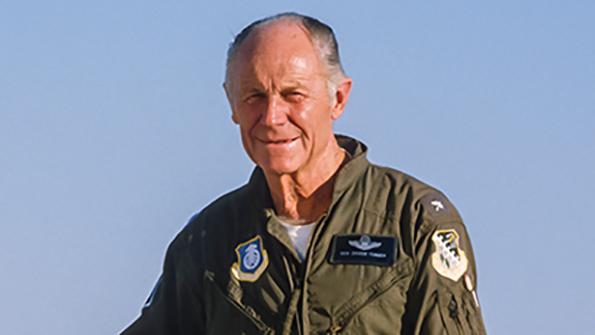An Appreciation: Aviation Legend Chuck Yeager

Charles E. “Chuck” Yeager joined the U.S. Army in September 1941 out of high school to become an enlisted aircraft mechanic. Within seven years, the Myrna, West Virginia, native would become the first human to travel faster than the speed of sound.
Yeager died on Dec. 7 in Los Angeles. He was 97.
After pilot training, Yeager flew P-51s with the legendary 357th Fighter Group during World War II. He evaded capture after being shot down over German-occupied France, returning to combat to end the war with 11 kills, illustrating the combination of luck, ego and innate airmanship that marked his life.
Yeager’s career path shows how innovation in the first half-century of aviation belonged not just to scientists and engineers but also to the mechanics. Massachusetts Institute of Technology-trained Jimmy Doolittle mixed in the same test-pilot circles as Lockheed’s Tony LeVier, a former barnstormer. Aerodynamics was being crafted as much by theoreticians like Theodore von Karman as by high school-trained mechanics-turned-designers such as Jack Northrop.
Yeager graduated from the Air Force’s test-pilot school and spent a year at the Air War College in 1962. He built a career on the genius with which he handled the stick and rudder pedals in any of his long and esteemed list of aircraft cockpits. The feat of breaking the sound barrier drew on his courage more than any piloting skills, however. In interviews, Yeager combined the brash self-confidence of a fighter pilot with the technical acuity of a test pilot. Duty compelled him to accept a role as the Bell X-1 test pilot, despite the obvious risks.
Rifle bullets traveled two to three times the speed of sound long before Yeager exceeded Mach 1 in the X-1. But bullets do not have wings and control surfaces, and flight at transonic speed—where some of the airflow over the airframe is subsonic and some is supersonic—creates dangerous buffeting and baffling control forces in an aircraft optimized for subsonic speed. Overcoming those effects in the transonic regime already had killed many pilots including Geoffrey de Havilland, Jr., in his attempt in 1946 to conquer the sound barrier in a DH108.
But the X-1 had advantages not available to the DH108. The first was a fixed horizontal tail with a lower thickness-to-chord-ratio than the wing. Airflow passed over the wing and tail at different speeds, so a supersonic shockwave could not compromise both at the same time. On the first subsonic test flights of the X-1, this allowed Yeager to land safely even after the shockwave settled over the tail’s elevator at Mach 0.88.
To overcome that transonic speed barrier, the X-1’s designers also installed a moving tail. First proposed for the UK’s canceled Miles M.52, this feature meant Yeager still could control the aircraft in pitch by moving the entire horizontal stabilizer instead of only the elevator tab. The details of his first supersonic flight on Oct. 14, 1947, are now legend, including his broken ribs and, not least, the secret feat’s exposure two months later in an exclusive Aviation Week report.
The newly established U.S. Air Force would entrust other flying laboratories to Yeager, including the Lockheed YF-104, a captured Mikoyan MiG-15 and the X-1A. The latter established Yeager again as the world’s fastest pilot, but briefly. Yeager set a new airspeed record of Mach 2.44 in level flight at 74,700 ft. Moments later, he became one of the first pilots to encounter the dangerous phenomenon of inertial roll coupling but managed to regain control of the aircraft after plunging around 50,000 ft. (15,240 m).
Between operational squadron commands, Yeager almost played another historic role. In the early 1960s, the Air Force competed with NASA for manned space missions, envisioning Boeing X-20 Dyna-Soar spaceplanes ferrying military astronauts to a manned orbital laboratory or releasing nuclear bombs from space. Yeager in 1963 was assigned to be commandant of the Air Force’s astronaut school. But the assignment was short-lived. Not long after he crashed one of the school’s Lockheed NF-104s, the Air Force canceled the program, ceding orbit to NASA’s peaceful pursuits. The decision never sat well with Yeager’s tempestuous personality. Although denied his final contribution to aerospace science in uniform, the former aircraft mechanic retired in 1975 as a brigadier general.
In retirement, Yeager’s name recognition transitioned into genuine fame, thanks to commercial appearances and the 1983 film “The Right Stuff.” From an 18-year-old mechanic at California’s Moffett Field to a 25-year-old captain receiving the McKay Trophy for breaking the sound barrier, his path defined an era of singular achievement driven by skill, courage and a bit of luck.





Comments
De Havilland was deep in the transonic -- around M .87-8 when he was killed, but was not trying for M1 at the time. The M.52 misinformation is propagated in Brown's valuable and a bit sad book, but another British study refutes this and is historically correct.
The Mach 2.44 record was made in a shallow dive, as is clear from Yeager's account (and the NACA data).
(I am pretty sure my father flew with Yeager on a test flight around 1948 -- in a late test of a troop glider.)
Bernard Biales